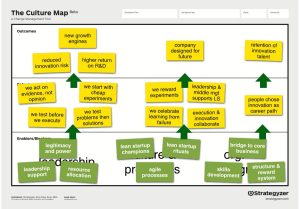At least once every couple of seasons you should get leadership or teams into a room to map out and discuss your teams existing or desired culture.
Collaboration is key, so try out the following approach:
The way I do it is to imagine our culture as a garden, this as the analogy of a garden helps the team to visualize their culture within the “Culture Map.”

Focus on discussing one area of your culture at a time. Whether you started by mapping out an outcome or a behavior, it’s important to conduct the conversation around that space before trying to tackle other areas of your culture.
There can be a tendency to describe behaviors in an abstract way. In your Culture Map exercise you might hear people say “There’s a lack of teamwork” or “People have attitude”. What does that mean? What’s actually happening? Coaches, Captains and teams have probably talked to each other so much about these issues, that it’s become an easy way to explain negative results.
Get participants to tell a story with specific examples. Have them describe a scene in the movie where they can provide detail around the lack of teamwork. This might result in a more specific example like “People agree to something at training, but then do not deliver in the game”. It’s also important that participants get into the habit of sharing evidence rather than simply stating opinions, so specific stories of behavior (good and bad) can be based on proof rather than a rumour.
It’s up to you to decide if your session should start top down by tackling outcomes and then the associated behaviors, enablers and blockers. However we have found that starting with behaviors can be an easy place to start. Behaviors are the things you see everyday; the things people go to the bar or out to lunch to talk about.
Focus the conversation by asking these questions: What does a great game look like? What does a terrible game look like? Participants might respond that a great game meant winning or playing in a certain style – THEN – Why? Because everyone was “motivated”.
Ask the team: what causes and influences our behaviors? What are you as a leader saying or doing to enable these behaviors? How are people rewarded for their behaviors in your culture (both positive and negative)? What are the unwritten rules? How does your current process help or hinder your culture? This is the space to assess your current culture, and the space where you can design the culture that you want.
Now that you’ve got an aspirational map of the culture you want after your session, take that map and place it in a space where everyone can see it and be reminded of the tasks ahead. Put them up at training or in briefings.
Look at the map you’ve created and frequently assess if your culture has moved from the current state to its desired state. Has the culture you mapped out enacted enablers that resulted in the behaviors and outcomes you desired? How have hurtful blockers been removed from your culture? Your teams can regroup at frequent intervals to assess, learn, and evolve the team Culture Map. Integrate the document into seasonal reviews to ensure all captains, coaches and teams follow the desired culture that was created.
The process of regularly separating outcomes, behaviors, enablers and blockers will allow your team to organize and assess the elements that should remain or be removed. Participants will also recognize that everything is within the power of YOUR TEAM to change.
Download blank culture map here
Adapted to reflect a sports environment from https://www.strategyzer.com/